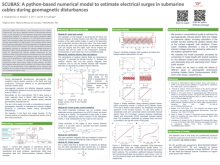SCUBAS: A python-based numerical model to estimate GMD-driven electrical surges in submarine cables
Shibaji
Chakraborty
Virginia Tech
Poster
Submarine cables have become a vital component of our modern infrastructure. They carry a significant amount of international internet traffic, so any disruption to their operation would have wide-ranging consequences. However, it is uncertain how modern submarine cables systems would behave in an extreme (1 in 100 years) space weather event. Thus, submarine cables, like other critical infrastructure, need to consider space weather as High Impact, Low Frequency (HILF) events which require an assessment of risk and preparation of mitigation action if necessary. The aim of this study is to build a computational model of geomagnetic induction to calculate the induced voltages produced in submarine cables during geomagnetic disturbances. We present the theory for estimating the induced voltages experienced by the submarine cables during geomagnetic disturbances and then describe implementation of a Python-based software model to be used by end-users, such as researchers or cable engineers. The model requires the specification of a number of parameters, such as Earth-water conductivity structure, depth, length of cable sections, and earth conductivity model, and then uses magnetic observatory data to estimate the induced cable voltages. As part of the demonstration of the capabilities of the software and validation of the model, we describe several applications and examples of the software. In conclusion, we will discuss the various capabilities and limitations of the current computational model and the potential extensions of the software in the near future.

Poster PDF
Poster category
Geospace/Magnetosphere Research and Applications
Meeting homepage